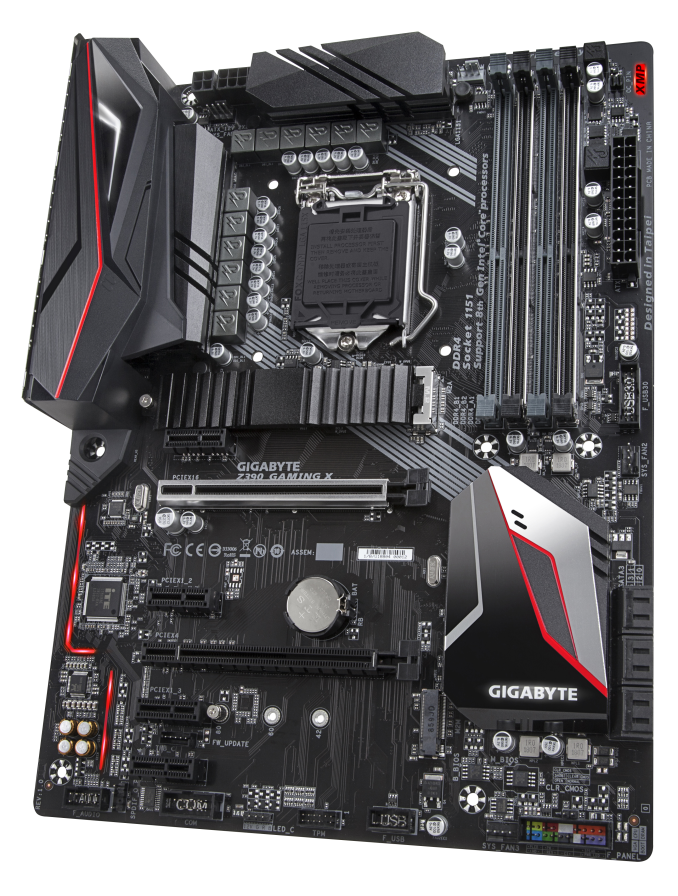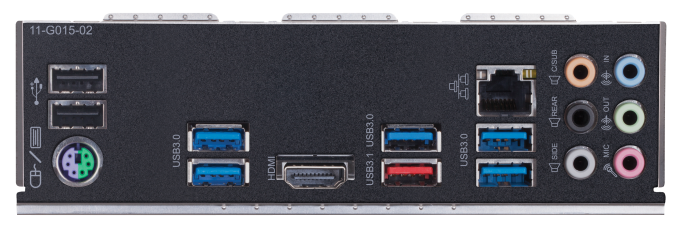Intel Z390 Motherboard Overview: 50+ Motherboards Analyzed
by Ian Cutress & Gavin Bonshor on October 8, 2018 10:53 AM EST- Posted in
- Motherboards
- Intel
- MSI
- Gigabyte
- ASRock
- EVGA
- Asus
- NZXT
- Supermicro
- Z390
GIGABYTE Z390 Gaming X
The GIGABYTE Z390 Gaming X looks to share a very similar PCB and design as the Z390 Gaming SLI with a black and silver design (red accents) but looks to enter the market at a lower price point. Both boards feature much of the same characteristics including power delivery, dual 8 and 4-pin CPU power inputs and PCIe slot layout, but replaces Realtek ALC1220-VB codec and instead opts for a cheaper Realtek ALC892. The Gaming X drops SLI support and features two full-length PCIe 3.0 slots which run at x16 and x4 respectively. The top slot also has a coating of metal PCIe slot protection and two-way CrossFire is officially supported; there are also three PCIe 3.0 x1 slots included on the board.
On the storage front, the Z390 Gaming X has a pair of PCIe 3.0 x4/SATA M.2 slots with the top slot being treated to an M.2 heatsink. The board also has a total of six SATA ports which allow for RAID 0, 1, 5 and 10 arrays to be used. The board also offers a maximum capacity of up to 64 GB of system memory, with the rated XMP specification currently unknown as of yet.
USB wise the board has a total of eight ports which consist of one USB 3.1 Gen2 Type-A, five USB 3.0 Type-A and two USB 2.0 ports; an additional two USB 3.0 and two USB 2.0 ports can be made available through the internal headers on the board. The rest of the rear panel consists of a single HDMI out, a PS/2 combo port, a single LAN port powered by an Intel I219V Gigabit controller and six 3.5 mm audio jacks which are controlled by a Realtek ALC892 HD audio codec.
The GIGABYTE Z390 Gaming X's pricing stands at $150 as it sits towards the bottom of GIGABYTEs Z390 product range. The board is aimed towards gamers with lower budgets and looks to make GIGABYTE competitive in the entry-level Z390 market.












79 Comments
View All Comments
Valantar - Wednesday, October 10, 2018 - link
That would be pretty shocking, yeah, but the sheer size of that lump of metal still has me a bit worried. Guess that's what you get when you try to squeeze power delivery for a CPU that (likely) pulls >300W when overclocked into an ITX board (and refuse to use riser boards like before, for some reason).FXi - Monday, October 8, 2018 - link
The power feed also changed with z390 I believe at least in the Asus models it did. The power feed of the 370 was "enough" to drive the newer 9700/9900 but there is a difference there that may impact enthusiasts. I don't think it enough to warrant an upgrade but something to consider.Also people should remember that while it is still a bit of a ways off, wifi is going to change to Wifi6 or 802.11ax starting now and probably seeing much of the changeover during 2019/2020 depending on adoption choices. And there is also pci-e 4.0 to consider next year probably that should be thought about before people do "marginal" upgrades from 370 era chipsets.
FXi - Monday, October 8, 2018 - link
Silly thing posted in edit window. Sorry power delivery and other points covered by you. Would have edited if I could have found that optionDanNeely - Monday, October 8, 2018 - link
Other things to look forward to in the next few generations are: Less-hacky USB3.1 implementations (eg this articles speculation that a 10g port will need to eat 2 HSIO lanes instead of 1, and still needing an extra chip to support USB-C). Spectre/Meltdown fixes in hardware. A reduced DMI bottleneck between the CPU and chipset (either just from upgrading the link to PCIe4/5, moving some of the peripheral IO onto the CPU, or both.Valantar - Wednesday, October 10, 2018 - link
Considering that the maximum theoretical bandwidth of PCIe 3.0 x1 is 984.6MB/s, you _need_ two PCIe lanes (and thus two HSIO lanes) for a USB 3.1G2 (1.25GB/s) controller unless you want to significantly bottleneck it. That's not "hacky", that's reality, even if this leaves a lot of bandwidth "on the table" if this only powers a single port (which it rarely does, though, and given that a full load on two ports at one time is unlikely, running two 1.25GB/s ports off two .99GB/s lanes is a good solution).Moving DMI to PCIe 4.0 will be good, though, particularly for multiple NVMe SSDs and >GbE networking.
DanNeely - Wednesday, October 10, 2018 - link
Splitting the traffic over 2 HSIO lanes is a hack because it'd require something to split/combine the traffic between the chipset and usbport. That in turn has me wondering if the speculation about the implementation being done that way is correct, or if the Z390 has 6 HSIO lanes that can run 10Gbps instead of the 8 that the rest top out at for PCIe3repoman27 - Thursday, October 18, 2018 - link
The implementation is absolutely not done that way. HSIO lanes are simply differential signaling pairs connected to a PCIe switch or various controllers via a mux. The PCH has a 6-port USB 3.1 Gen 2 xHCI, which can only feed 6 HSIO muxes. The back end of that xHCI is connected to an on-die PCIe switch which in turn is connected to the DMI interface. That DMI 3.0 x4 interface is already massively oversubscribed, but it is at least equivalent to a PCIe 3.0 x4 link, which is the most bandwidth that can be allotted to a single PCH connected device.Srikzquest - Monday, October 8, 2018 - link
HDMI 2.0 is available in Asus and Gigabyte's ITX boards as well.gavbon - Tuesday, October 9, 2018 - link
Thank you Srikzquest; updated the tables, obviously missed this yesterday :) - Thanks againHickorySwitch - Monday, October 8, 2018 - link
Correction:https://www.asus.com/us/Commercial-Servers-Worksta...
It says under "Specifications" that the board sports HDMI 2.0[b?]